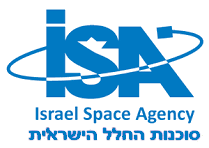
Ariane 5 is a retired European heavy-lift space launch vehicle developed and operated by Arianespace for the European Space Agency (ESA). It was launched from the Guiana Space Centre (CSG) in French Guiana. It was used to deliver payloads into geostationary transfer orbit (GTO), low Earth orbit (LEO) or further into space. The launch vehicle had a streak of 82 consecutive successful launches between 9 April 2003 and 12 December 2017. Since 2014, Ariane 6, a direct successor system, first launched in 2024.

Israel Aerospace Industries, is Israel's major aerospace and aviation manufacturer, producing aerial and astronautic systems for both military and civilian usage. It has 14,000 employees as of 2021. IAI is state-owned by the government of Israel.

Falcon 9 is a partially reusable, human-rated, two-stage-to-orbit, medium-lift launch vehicle designed and manufactured in the United States by SpaceX. The first Falcon 9 launch was on 4 June 2010, and the first commercial resupply mission to the International Space Station (ISS) launched on 8 October 2012. In 2020, it became the first commercial rocket to launch humans to orbit. The Falcon 9 has an exceptional safety record, with 381 successful launches, two in-flight failures, one partial failure and one pre-flight destruction. It is the most-launched American rocket in history.

The Israel Space Agency is a governmental body, a part of Israel's Ministry of Science and Technology, that coordinates all Israeli space research programs with scientific and commercial goals.

AMOS is a series of Israeli communications satellites operated by Israel-based Spacecom. All AMOS satellites were developed by Israel Aerospace Industries (IAI) using the AMOS bus satellite bus, except for AMOS-5 which was developed by ISS Reshetnev using the Ekspress bus satellite bus, and AMOS-17 which was developed by Boeing on its BSS-702.
AsiaSat 2 was a Hong Kong communications satellite, which was owned, and was initially operated, by the Hong Kong–based Asia Satellite Telecommunications Company. It was positioned in geostationary orbit at a longitude of 17° East of the Greenwich Meridian, on lease to Spacecom. It spent most of its operational life at 100.5° East, from where it was used to provide fixed satellite services, including broadcasting, audio and data transmission, to Asia and the Pacific Ocean.
Spacecom, or Space Communication, is an Israeli communications satellite operator in the Middle East, European Union and North America headquartered in the city of Ramat Gan, Israel. Spacecom operates two satellites at orbital position 4° West – AMOS-3 and AMOS-7, one satellite at orbital position 65° East – AMOS-4, and one satellite at orbital position 17° East – AMOS-5.
AMOS-1, then Intelsat 24, was a commercial communications satellite which was operated by Spacecom as AMOS-1, for Affordable Modular Optimized Satellite and formed part of the AMOS series of satellites. It was the first Israeli civilian communications satellite, and was initially positioned at 4° West longitude in geostationary orbit. Then in September 2011, it was moved to 31° East.
AMOS-3, also known as AMOS-60, is an Israeli communications satellite operated by Spacecom Satellite Communications.

SpaceX manufactures launch vehicles to operate its launch provider services and to execute its various exploration goals. SpaceX currently manufactures and operates the Falcon 9 Block 5 family of medium-lift launch vehicles and the Falcon Heavy family of heavy-lift launch vehicles – both of which are powered by SpaceX Merlin engines and employ VTVL technologies to reuse the first stage. As of 2024, the company is also developing the fully reusable Starship launch system, which will replace the Falcon 9 and Falcon Heavy.
AMOS-4 is an Israeli commercial communications satellite, operated by Spacecom Satellite Communications, Tel Aviv-based, part of the AMOS series of satellites.

AsiaSat 8 then AMOS-7 is a Hong Kong-turned-Israeli geostationary communications satellite which is operated by the Asia Satellite Telecommunications Company (Asiasat).

Firefly Aerospace is an American private aerospace firm based in Cedar Park, Texas, that develops small and medium launch vehicles for commercial launches to orbit. The company completed its $75 million Series A investment round in May 2021, which was led by DADA Holdings. The current company was formed when the assets of the former company Firefly Space Systems were acquired by EOS Launcher in March 2017, which was then renamed Firefly Aerospace. Firefly's stated purpose is to increase access to space, similar to other private spaceflight companies.
Space launch market competition is the manifestation of market forces in the launch service provider business. In particular it is the trend of competitive dynamics among payload transport capabilities at diverse prices having a greater influence on launch purchasing than the traditional political considerations of country of manufacture or the national entity using, regulating or licensing the launch service.
The AMOS, an acronym for Affordable Modular Optimized Satellite, is a family of light weight satellite bus for geostationary orbit communications satellite designed and manufactured by Israel Aerospace Industries (IAI) of Israel.

This is a corporate history of SpaceX, an American aerospace manufacturer and space transport services company founded by Elon Musk.

Beresheet was a demonstrator of a small robotic lunar lander and lunar probe operated by SpaceIL and Israel Aerospace Industries. Its aims included inspiring youth and promoting careers in science, technology, engineering, and mathematics (STEM), and landing its magnetometer, time capsule, and laser retroreflector on the Moon. The lander's gyroscopes failed on 11 April 2019 causing the main engine to shut off, which resulted in the lander crashing on the Moon. Its final resting position is 32.5956°N, 19.3496°E.
AMOS-17 is an Israeli commercial communications satellite, part of the AMOS series of satellites.
AMOS-8 was a planned Israeli communications satellite, one of the Spacecom AMOS series, to be built by Maxar Technologies, a US defense and aerospace company, to replace AMOS-3 and AMOS-7










